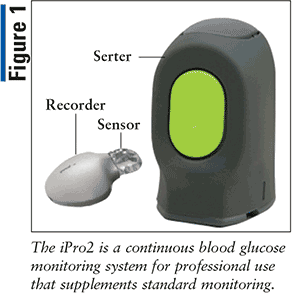US Pharm. 2018;43(5):31-32.
Diabetes mellitus refers to a heterogeneous group of disorders distinguished by the body’s inability to control glucose because of defects in insulin secretion, insulin action, or both.1 Diabetes is classified as gestational, type 1, or type 2. Gestational diabetes is defined as any degree of glucose intolerance that occurs with the onset of pregnancy. Type 1 diabetes results from cell-mediated autoimmune destruction of the beta cells of the pancreas, usually leading to absolute insulin deficiency.2 Type 2 diabetes occurs in individuals with insulin deficiency or insulin resistance.
Epidemiology
According to the 2017 National Diabetes Statistics Report by the CDC, an estimated 30.3 million people of all ages in the United States had diabetes in 2015.3 Additionally, more than 7 million individuals were undiagnosed. Prevalence was higher among American Indians/Alaska Natives (15.1%), non-Hispanic blacks (12.7%), and Hispanics (12.1%) compared with non-Hispanic whites (7.4%) and Asians (8.0%).3
Etiology
Type 1 diabetes mellitus may be due to genetic or environmental factors, such as viruses (i.e., mumps, rubella). Type 2 diabetes mellitus may also be a result of environmental and genetic factors, such as family history, obesity, and a history of gestational diabetes.4
Management
Diabetes mellitus is characterized by hyperglycemia; symptoms include polyuria, polydipsia, weight loss, polyphagia, and blurred vision.4 Additionally, uncontrolled diabetes may lead to loss of vision, renal failure, foot ulcers, amputation, sexual dysfunction, diabetic ketoacidosis, hyperglycemic hyperosmolar syndrome, and cardiovascular issues. To avoid or reduce the risk of diabetic complications, lifestyle modifications, pharmacologic therapy, and routine blood glucose monitoring are requisite for optimal diabetes management.
Self-monitoring of blood glucose usually requires intermittent capillary blood sampling and the use of a glucose meter. Different pharmacologic therapies and various frequencies of glucose testing may be required for type 1 and type 2 diabetes. Although it is important for diabetic control, many patients are noncompliant with monitoring and experience unwanted complications.5
Continuous Blood Glucose Monitoring
Glucose monitoring is one of the key pillars of proper diabetes management. However, underutilization of standardized glucose data collection and analysis are key contributors to poor glycemic control. To this end, the advent of continuous blood glucose monitoring (CBGM) is a significant stride forward in the ability to better understand glycemic fluctuations. In fact, CBGM with glucose measurements as often as every 5 minutes and glucose-trend information has the capability of better informing diabetes-management decisions compared with traditional testing.6 As such, more CBGM devices need to be developed to monitor blood glucose and mitigate diabetic impediments.
iPro2 CBGM System
The iPro2 (Figure 1) is a CBGM system for professional use that measures blood glucose levels and gives healthcare providers insight into the impact of diet, medications, and exercise.7,8 Intended as a supplement to standard monitoring, it is a small, lightweight, and watertight device that tracks glucose readings every 5 minutes for up to 6 days. Although the device records up to 144 hours, data are not available to patients until they visit the physician’s office. Additionally, the iPro2 records up to 288 glucose readings per day and displays such readings in a personalized report. Instructions for healthcare providers and patients are listed in Tables 1 and 2, respectively.9
Efficacy
A 3-month study by Mohan and colleagues evaluated the use of retrospective continuous glucose monitoring to optimize management of type 2 diabetes.10 Adults with A1C values between 8% and 10% were eligible, and participants were scheduled for five visits. During the first visit, baseline A1C values were recorded. The second, third, and fourth visits included downloading iPro2 data, reviewing the report, and initiating therapy modifications. The second A1C values were obtained at the fifth visit between days 78 and 92 of the study. At the end of the study, the report showed a mean A1C decline from 8.6% at baseline to 8.0% at the third month. Therapy modifications were prescribed for most subjects (91.2%) after review of the first iPro2 test. Therefore, mean A1C reduction suggests the ability of iPro2 to facilitate optimal management of diabetes.
Conclusion
This CBGM device has demonstrated some evidence of effectiveness in the management of diabetes and provides supplementary information for the healthcare practitioner. More information can be found at http://professional.medtronicdiabetes.com/ipro02-professional-cgm.
REFERENCES
1. Alam U, Ashgar O, Azmi S, Malik RA. General aspects of diabetes mellitus. In: Zochodne DW, Malik RA, eds. Handbook of Clinical Neurology. Philadelphia, PA; Elsevier. 2014:211-222.
2. Pietropaolo M. Prediction of type 1 diabetes mellitus. Updated January 31, 2018. UpToDate. www.uptodate.com/contents/prediction-of-type-1-diabetes-mellitus. Accessed November 15, 2017.
3. CDC. National diabetes statistics report, 2017. www.cdc.gov/diabetes/data/statistics/statistics-report.html. Accessed November 16, 2017.
4. American Diabetes Association. Diagnosis and classification of diabetes mellitus. Diabetes Care. 2009;32(1 Suppl):62-67.
5. Ward JEF, Stetson BA, Mokshagundam SPL. Patient perspectives on self-monitoring of blood glucose: perceived recommendations, behaviors and barriers in a clinic sample of adults with Type 2 diabetes. J Diabetes Metab Disord. 2014;14:43.
6. Beck RW, Riddlesworth T, Ruedy K. Effect of continuous glucose monitoring on glycemic control in adults with type 1 diabetes using insulin injections: the DIAMOND randomized clinical trial. JAMA. 2017;317(4):371-378.
7. Medtronic. Products. iPro 2 Professional continuous glucose monitoring (CGM).
www.professional.medtronicdiabetes.com/ipro2-professional-cgm. Accessed November 12, 2017.
8. Medtronic. Products. A simple way to better control your diabetes. www.medtronicdiabetes.com/sites/default/files/library/download-library/user-guides/iPro2-with-Enlite-User-Guide.pdf. Accessed November 12, 2017.
9. Medtronic MiniMed. “iPro2 User Guide.” www.medtronicdiabetes.com. Accessed November 12, 2017.
10. Mohan V, Jain S, Kesavadev J, et al. Use of retrospective continuous glucose monitoring for optimizing management of type 2 diabetes in India. J Assoc Physicians India. 2016;64:16-21.
To comment on this article, contact rdavidson@uspharmacist.com.








